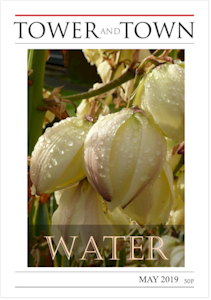

Tower and Town, May 2019 (view the full edition) (view the full edition)As The Iranians Say"Ab Chesmeh -ye- Zendegi Ast" or "Water Is The Source Of Life" In 1950 four Oxford undergraduates went on an expedition to Persia to look for a species of sightless fish that was rumoured to inhabit the country's underground aqueducts. Their adventures were written up by one of them, Anthony Smith, who later became a prominent science journalist and TV presenter, in an amusing travelogue entitled 'Blind White Fish in Persia'. They failed to find the fish, though Smith discovered one on a return visit in 1976 and brought it back to the Natural History Museum in London, where they named this newly-discovered species after him. The underground water channels that they explored, called qanats in Persian, are the traditional means of bringing water from sources in the mountains to towns and villages in the plains for domestic use and most importantly for agriculture. I have come across one which is 60 km long and was constructed 2400 years ago. In a country where 60% of the land is arid, these man-made water channels 'make the dry places green'. It was estimated in 1950 that up to half the male population of the countryside was engaged in excavating and repairing the tunnels and access shafts of the qanats to keep these vital channels open. But things have changed. In the last half century in Iran, with a doubling of the population, decreasing rainfall (despite the amazing countrywide precipitation and flooding at the end of March), and poor government water management, 30,000 villages have been abandoned and their inhabitants have migrated to already overcrowded towns. There have been anti-government protests at the increasingly severe shortage of water. The construction of 600 dams in the last forty years has not provided a satisfactory solution. The regime has blamed foreign powers for "stealing our clouds". Of the countries of the world that will be suffering 'extreme water shortage' in 20 years' time half are in the Middle East, and of all the industrialized nations in the world Iran, arguably, faces the most severe outlook. In many countries which are far from self-sufficient and rely on increasingly expensive imported food supplies there is the prospect of an even greater movement of people away from the countryside and increasing civil unrest. As we have been reminded recently in our own press, this country, too, should be addressing the business of providing adequate supplies of water in an era when there is, and will continue to be, less available and an increased need. (Writing this, I owe a large debt to a recent article by Prof Afshin Shahi of the University of Bradford in the Journal of the Royal Society for Asian Affairs.) John Osborne |